Ludington House (A.K.A. Ludington-Thacher House)
Introduction
Text-to-speech Audio
The historic home is known for two principal figures: Reuben W. Ludington, one of the town's first entrepreneurs and town mayor, and Solon O. Thacher, a lawyer, judge, politician, newspaper editor, and representative at the 1869 Wyandotte Constitutional Convention (Kansas Constitution) in 1859. Thacher also visited Mexico and South America as part of President Chester Arthur's selected trade commission. The home stood among many lavish homes that arose on Tennessee Street during the 1860s and 1870s, ostensibly serving as status symbols for the economic and political elites of the period.
Images
Ludington-Thacher House
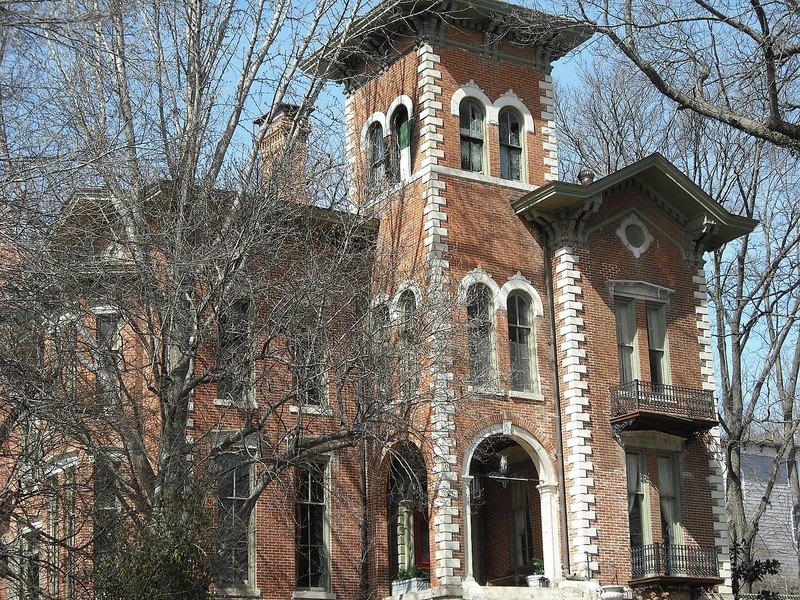
Reuben Winchell Ludington
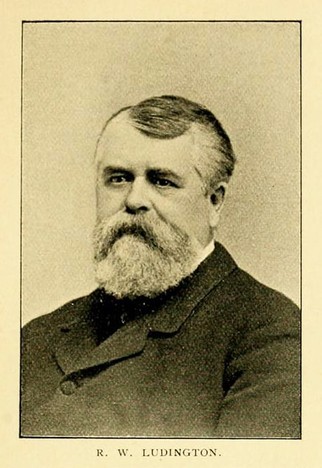
R.W. Ludington business advertisement
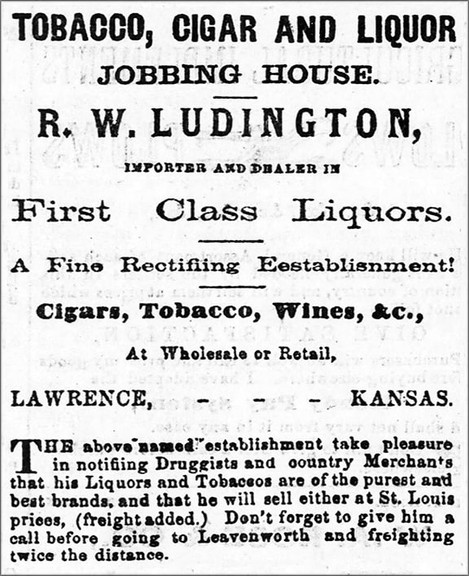
R.W. Ludington business advertisement
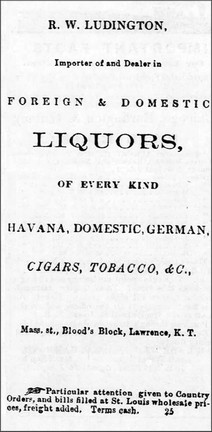
Solon O. Thacher
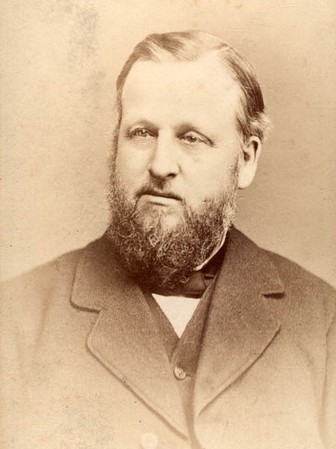
Backstory and Context
Text-to-speech Audio
Ludington was born in West Springfield, Holyoke, Hampden County, Massachusetts, on September 1, 1827. His father was an orderly sergeant in the War of 1812, and both his grandfathers served as officers in the Revolutionary War. Ludington attended "common schools" of New England, receiving the equivalent of a business education. After graduating in 1845, he moved to Hartford, Connecticut, and worked as a successful clerk and salesman for three years. He moved back home to Holyoke in 1849, married, opened a store, established a post office at Rock Valley, and served as the first postmaster. In the spring of 1857, Ludington came to Kansas. He first started a livery business before opening a mercantile store in 1859 on Massachusetts Street; his success led to him becoming one of the city's first prominent entrepreneurs.
Like many New Englanders who moved to Lawrence, they held strong anti-slavery beliefs. Lawrence evolved into a hub of abolitionism and a home to fugitive and newly freed slaves. Moreover, prominent men led raids on Missouri towns, which included plundering (and taking freed slaves back to Lawrence). William Quantrill, an officer commissioned by the Confederacy in 1861 to form and lead guerilla troops, led a devastating and deadly raid on Lawrence on August 21, 1863. Quantrill and several hundred men arrived in the early morning and, by the time they had left, had burned much of town to the ground and killed at least 150 men and teenage boys, roughly one-quarter of the male population older than fifteen. During Quantrill's Raid, Ludington and his family were visiting family in Massachusetts. The bushwhackers did burn down two of Ludington's buildings, but being out of town likely saved his life.
It took Ludington a decade to recover the wealth he lost due to Quantrill's attack. By 1867, Ludington was a distiller, rectifier, and dealer in wines, liquors, "Lud's Bitters," lamp chimneys, coal oil, and tobacco. In addition to rebuilding his businesses, the town elected Ludington as mayor in 1864; he succeeded a victim of the raid. The war still ongoing at that point, Ludington also served as a member of Company E, Third Kansas Militia.
Although two theories exist regarding the building of the historic home, the latest (convincing) research shows that Ludington likely purchased the now-historic home from Lida & Thomas Eldridge in 1869, who had purchased the land in 1863. The Ludington family began constructing a new front part of the house by July 1870, completed in 1872. Ludington purchased the home during Lawrence's "City Building" period, a decade-long period of robust economic and population growth. The estate stood among several lavish homes on Tennessee Street, between 14th Street and 17th Street, conveying their success (wealth).
Ludington sold the house in 1873 but remained in Lawrence. He fulfilled two more stints as mayor, winning elections in 1876 and 1877, and continued to expand his enterprises, notably as a merchant and wholesale grocery operator. He also took on other roles, including president of the Lawrence Street Railway Company, director of the Second National and Lawrence Exchange Banks, and director of the St. Louis, Lawrence, and Southwestern Railroad Company. Ludington spent the last few years of his life running a farm; he died in 1905.
Solon O. Thacher purchased the home in 1873 from the Ludington family. Thacher, born in Steuben County, New York (1830), moved to Lawrence with his wife, Sarah, in 1858. Thacher amassed tremendous wealth as a lawyer, judge, ambassador, editor, and politician. Towards the end of his life, he also took on the role of State Historical Society president.
Thacher was one of the proprietors of the Lawrence Journal from 1859-1860. In 1859, Thacher served as chairman of the Wyandotte Constitutional, who met to write the state constitution. He also served several spans as regent of the University of Kansas and held the chair of equity jurisprudence in the University's law school. He was appointed the Fourth Judicial District judge in 1861 and then ran unsuccessfully for governor in 1864. After he lost the election, he focused solely on his law practice until 1880, when Thacher was elected to the state senate, a position he held until he died in 1895 (during his tenure, he again ran another unsuccessful gubernatorial bid). At the end of his first state senate term, he achieved notoriety as a member of the South American Commission, a group sent by President Chester Arthur to tour Mexico and several South American nations, with trade discussions a central theme of the mission. Although the voyage ultimately proved successful, it included a tiring and challenging voyage covering 34,000 miles and involving one dangerous shipwreck.
Sources
Alexander, Kathy. "Solon O. Thacher – Free-State Advocate & Politician." Legends of Kansas. December 2022. https://legendsofkansas.com/solon-o-thacher/.
--- --- --- "Wyandotte Constitutional Convention." Legends of Kansas. January 2023. https://legendsofkansas.com/wyandotte-convention/.
Doenecke, Justus. "Chester A. Arthur: Foreign Affairs." University of Virginia: Miller Center. Accessed April 8, 2024. https://millercenter.org/president/arthur/foreign-affairs.
Hernly, Stan. "1613 Tennessee Street, Lawrence Kansas: The Real Story." University of Kansas School of Architecture and Design. 1984. https://khri.kansasgis.org/photos_docs/045-3010-00002_3.pdf.
Kansas Historical Society. "Thacher, Solon Otis T." Kansapedia. May 2012. https://www.kshs.org/kansapedia/solon-otis-thacher/17094.
"Lawrence Locales: Couple caretakers of historic home." Lawrence Journal-Home. LJWorld.com. December 5, 2011. https://www2.ljworld.com/news/2011/dec/05/lawrence-locales-couple-caretakers-historic-home/.
Meyer, Ferdinand. "Lud's Aromatic Stomach Bitters – Lawrence, Kansas." Peachridge Glass. May 10, 2015. https://www.peachridgeglass.com/2015/05/luds-aromatic-stomach-bitters-lawrence-kansas/.
Tom & Carolyn Ward. "Thacher, Solon O. " ksgenweb.org. July 2002. https://www.ksgenweb.org/archives/1912/t/thacher_solon_o.html.
By Bhall87 at English Wikipedia, CC BY-SA 3.0, https://commons.wikimedia.org/w/index.php?curid=17979703
https://www.peachridgeglass.com/2015/05/luds-aromatic-stomach-bitters-lawrence-kansas/
https://www.peachridgeglass.com/2015/05/luds-aromatic-stomach-bitters-lawrence-kansas/
https://www.peachridgeglass.com/2015/05/luds-aromatic-stomach-bitters-lawrence-kansas/
https://legendsofkansas.com/solon-o-thacher/
